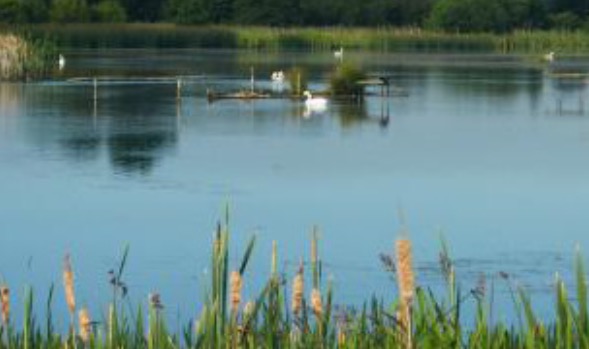Staveley Carrs
The natural wetlands of Staveley Carrs were drained for agriculture in the 1800s and later quarried for sand, gravel and clay. When quarrying ended, CEMEX UK created a wetland habitat reminiscent of the original landscape of 200 years ago.

Staveley Nature Reserve (Photo credit: P Fox)
Rare species found at the Staveley Nature Reserve:
- Water violet
- Grasshopper warbler
- Blue tailed damselfly
CEMEX relies on raw materials such as gravel, sand and clay to make its cement and concrete products. These are essential for building the roads, schools and homes that society needs, but quarrying the materials has the potential to degrade habitats and damage species unless the land is carefully managed. We are determined to have a positive impact on nature by promoting a diverse range of habitats and species while quarries are active, and by rehabilitating disused sites. By restoring former quarry sites we also provide communities with new nature reserves and education and leisure facilities.
The Staveley Nature Reserve in North Yorkshire is an example of a successfully restored quarry. In the 18th century, the site was part of an extensive natural wetland known for its rare marsh plants. The wetlands were drained for agriculture in the 19th century and quarried for building materials in the 20th century. We stopped quarrying for sand, gravel and clay in the 1970s and restored the site. Its complex ecology is now similar to the original wetlands.
We flooded the gravel pit when quarrying ended and allowed the site to regenerate naturally for 30 years, so the area could return to its original state.
In 2002, the Yorkshire Wildlife Trust bought the reserve from CEMEX UK. Local volunteers now work with the Trust on a more formal restoration scheme, managing the mosaic of wetland habitats to maintain their rich diversity.
A footpath alongside the lake and through the willow copse encourages local people to visit the reserve. A hide overlooking the water gives birdwatchers and photographers the perfect location to spot rare species and other wildlife in their natural environment.
Through natural regeneration, Staveley Nature Reserve has developed lots of different habitats including meadow, open water and reed bed. The main lagoon and surrounding reed swamp attract breeding and winter birds that are popular with naturalists and birdwatchers. Regularly sighted species include jack snipe, goldeneye and reed warbler.
The 84 hectare reserve is a Site of Importance for Nature Conservation (SINC) and a significant habitat for water insects and rare types of beetle.
The Wildlife Trust welcomes all visitors, from school groups and photographic clubs, to ramblers and insect enthusiasts. The reserve is particularly renowned for its rare plants.
With help from experts at the Royal Society for the Protection of Birds (RSPB), we have developed an ambitious ten-year biodiversity strategy. This sets challenging targets, including our goal to create and maintain, by 2020, 1,000 hectares of habitats identified by the UK Government as conservation priorities.
For more information please contact us or visit the wild life trusts website here.
